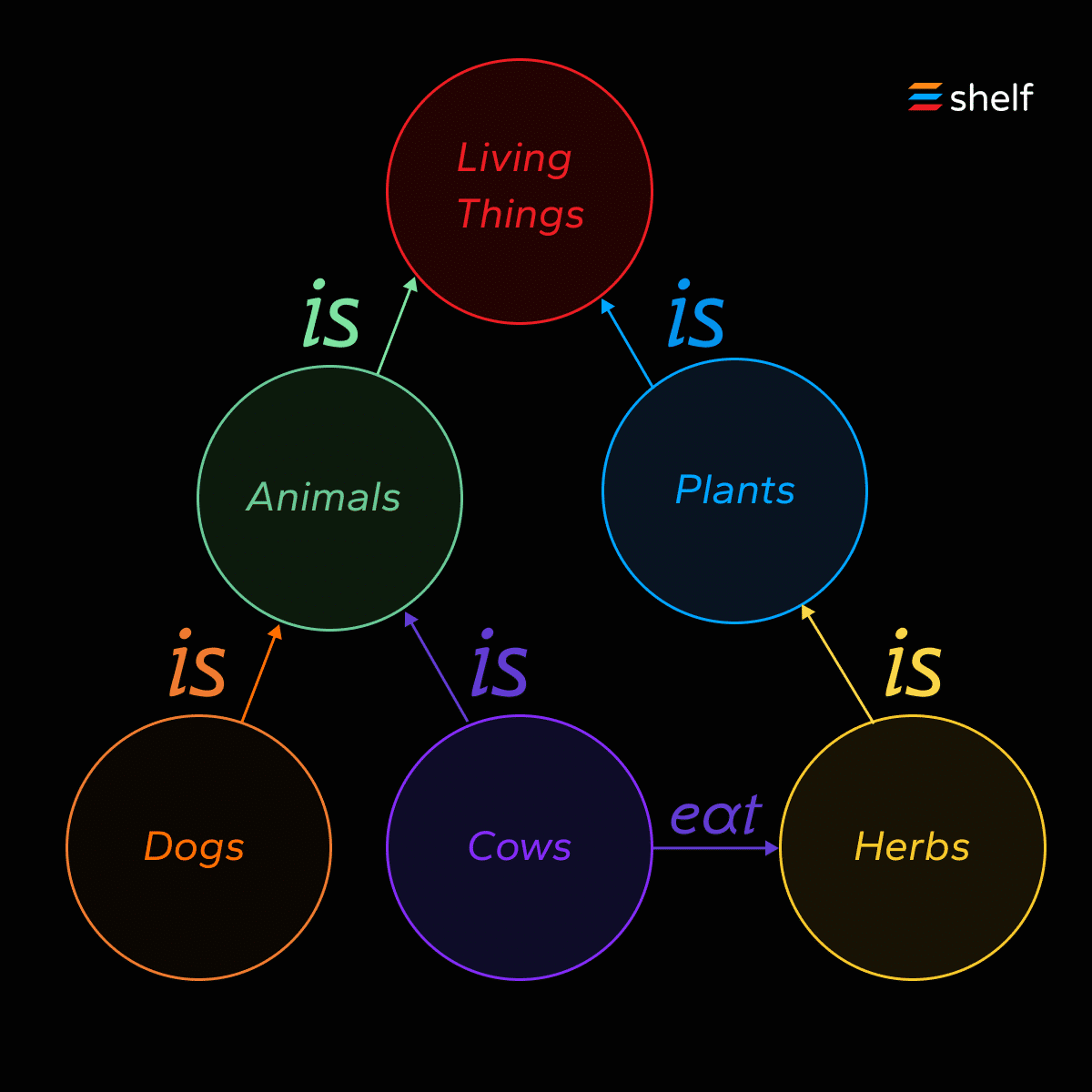A knowledge graph is a structure that connects diverse pieces of information. It helps you uncover relationships and insights that might not be apparent. It’s especially helpful when you need to bridge two types of data together, such as structured and unstructured data.
In this article, we provide a clear guide to building your first knowledge graph. We’ll show you how to connect structured and unstructured data and gain a new lens to view and analyze your information.
Understanding Structured and Unstructured Data with Knowledge Graphs
To build a knowledge graph that serves as a bridge between different data types, we first need to understand the distinct characteristics of structured and unstructured data.
What is Structured Data?
Structured data is highly organized and easily searchable due to its fixed schema. This data is stored in relational databases or spreadsheets, where each piece of information has a predefined model or format.
Some examples of structured data include customer names in a CRM system, sales figures in a spreadsheet, or transaction histories in a database. The predictability of structured data makes it straightforward to collect, query, and analyze.
What is Unstructured Data?
Unstructured data lacks a predefined format or structure, which makes it more challenging to collect, process, and analyze. This type of data encompasses a wide range of formats, including text files, emails, social media posts, videos, images, and more.
The richness and diversity of unstructured data offers a wealth of potential insights, but extracting these insights is challenging. It requires special processing techniques, such as natural language processing (NLP) or image recognition.
The Challenge of Linking Structured and Unstructured Data
The primary challenge in linking structured and unstructured data lies in their inherent differences. Structured data’s predictability is quite different from the free-form nature of unstructured data.
In order to link these two data types, you need an approach that can interpret and connect the underlying information within unstructured data to the organized format of structured data.
Why Integrate Structured and Unstructured Data?
Integrating structured and unstructured data gives you a comprehensive view of the information. You can extract deeper insights and make better decisions. For example, combining customer transaction data (structured) with customer feedback on social media (unstructured) can offer a more holistic view of customer satisfaction and behavior.
Knowledge Graphs for Linking Structured and Unstructured Data
Now that we understand structured vs. unstructured data, let’s turn to knowledge graphs. These are an indispensable tool in data science, especially for linking structured and unstructured data.

What is a Knowledge Graph?
Unlike traditional databases that store data in rows and columns, knowledge graphs depict data in a graph format. This creates an intuitive and flexible representation of complex relationships.
Advantages of Knowledge Graphs
- Flexible schema: Adaptable to evolving data models and relationships.
- Efficient querying: Handles complex queries involving multiple levels of semantic relationships.
- Semantic richness: Captures meaning and context through ontologies and vocabularies.
- Inference and reasoning: Discovers new, implicit knowledge based on semantic rules.
- Scalability: Distributes the graph across machines for efficient storage and processing.
- Data integration: Provides a unified view of data from diverse sources.
- Knowledge discovery: Facilitates intuitive exploration and uncovering of insights.
- NLP compatibility: Integrates with text mining and understanding techniques.
- Explainable AI: Provides a transparent foundation for explainable AI systems.
- Domain-specific representation: Tailors to specific fields or industries.
Components of a Knowledge Graph
A knowledge graph includes three main components. Let’s briefly explore the graph structure.
Nodes are the primary entities or objects in a knowledge graph, representing data points such as people, places, products, or concepts.
Edges connect nodes. They represent the relationships or interactions between nodes. These relationships can be varied and multidimensional, which reflects the complexity of real-world data.
Both nodes and edges can have properties. Properties provide additional details or attributes about their node or edge. For example, a node representing a person could have properties like name, age, and occupation.
Knowledge Graphs vs. Traditional Databases
While traditional databases excel in handling structured data with a fixed schema, they often fall short when it comes to managing complex and diverse data.
Modern knowledge graphs, on the other hand, are designed to accommodate this kind of complexity. They are well-suited for scenarios where relationships and connections between data points are as crucial as the data points themselves.
Linking Structured and Unstructured Data with Knowledge Graphs
Knowledge graphs excel in integrating structured and unstructured data because they can represent entities and relationships in a format that mirrors human understanding and cognition.
For instance, a knowledge graph can connect a structured database of customer information with unstructured data like customer reviews or social media posts. This integration creates more comprehensive analyses and insights of your customer relationships.
Visualizing Knowledge Graphs
Visualization is a powerful feature of knowledge graphs, providing a clear representation of complex relationships. Users can visually navigate through the connections, explore the network of relationships, and gain insights that would be challenging to obtain from traditional data representations.
Preparing Your Data
Before you can construct a knowledge graph that links structured and unstructured data, you’ll need to prepare your data, which involves several processes. Here’s how to lay the groundwork for a knowledge graph.
Step 1: Collecting Structured Data
Determine where your structured data resides. It could be in relational databases, spreadsheets, or cloud storage. Select only the data that is relevant to the relationships and insights you aim to derive.
Furthermore, make sure that the data is consistent in terms of format and units. For instance, dates should be in a uniform format across your datasets.
Step 2: Preparing Unstructured Data
Identify sources of unstructured data, such as text documents, emails, social media posts, or images. For textual data, use natural language processing (NLP) techniques to extract meaningful information.
Convert your text to a consistent format. This means you’ll have to account for variations in language or style. For images or videos, use appropriate techniques like image recognition or video analysis to extract relevant features or metadata.
Step 3: Data Cleaning and Normalization
Eliminate errors, duplicates, and irrelevant data points to ensure the quality of your data. Next, standardize data formats and values. For example, you should convert all text to lowercase or standardize date formats.
If you have missing data, decide how to deal with those missing values, whether it’s by imputation, removal, or leaving them as is, based on their impact on your knowledge graph.
Step 4: Transforming Unstructured Data into Structured Information
Use NLP to identify entities and their attributes within unstructured text. Entities then become nodes in your knowledge graph. Next, identify relationships between entities within unstructured data. These relationships will form the edges in your knowledge graph.
Finally, leverage metadata from unstructured data (like timestamps or geolocation from images) as structured data points in your knowledge graph.
Step 5: Ensuring Interoperability
Establish a schema that allows for the integration of both structured and unstructured data into the knowledge graph. Create identifiers or keys that can link data points across different datasets or data types, ensuring they can be connected within the knowledge graph.
Building Your First Knowledge Graph
With your data prepared and primed, it’s time to construct the knowledge graph. This process involves creating nodes and edges that represent your data entities and their relationships. Here’s a high-level, step-by-step guide.
Step 1: Define Your Nodes
First, identify the primary entities in your data. These entities could be customers, products, locations, or other significant concepts. For each entity in your structured data, create a node in your knowledge graph, ensuring that each node has a unique identifier. When dealing with unstructured data, you can transform key entities, such as those identified through natural language processing (NLP), into nodes to expand your graph further.
Step 2: Establish Relationships (Edges)
Once you have your nodes, the next step is to define relationships between them. Identify the relationships present in your structured data—like a customer “purchases” a product or a person “lives in” a location. You can also use NLP or other techniques to uncover relationships in unstructured data, such as someone “mentions” a product in a review. Each relationship becomes an edge in your graph, linking the appropriate nodes.
Step 3: Add Properties and Attributes
After defining nodes and edges, assign properties to them. For nodes, these could be attributes like age, gender, or purchase history for a customer. For edges, properties might describe the nature or strength of a relationship, such as how frequently entities interact or the context behind a connection.
Step 4: Integrate Structured and Unstructured Data
Link your structured and unstructured data by finding common reference points. For instance, a customer ID from your structured dataset might match a customer’s mention in an unstructured source, allowing you to link the nodes. Creating these cross-data edges helps enrich the graph by providing more depth and context to your data.
Step 5: Validate and Iterate
Finally, validate your knowledge graph by running queries to ensure it accurately reflects your data and yields meaningful insights. The process doesn’t stop here—iteratively refine and expand your graph as you explore it, making adjustments to enhance its accuracy and usefulness over time.

Knowledge Graph Usage Example
Let’s explore a fictional example of a knowledge graph. This will illustrate its practical application and show you how it can provide insights and enhance decision-making.
Imagine a retail company is looking to improve its customer experience and product offerings. The company has access to structured data, such as customer purchase histories and product details, as well as unstructured data, such as customer reviews and feedback on social media.
The goal is to create a knowledge graph that links customer information (structured data) with their feedback and reviews (unstructured data) to gain a holistic view of customer satisfaction and product performance.
Data Collection and Preparation
Extract customer profiles and purchase histories from the company’s database (the structured data). Then gather customer reviews and feedback from various platforms, including social media and the company’s website (the unstructured data).
Knowledge Graph Construction
Nodes creation: Establish nodes for customers, products, and feedback comments.
Edges creation: Link customers to their purchases, purchases to products, and customers to their feedback.
Data integration: Use NLP to extract sentiments and key themes from customer feedback. Link these as attributes or separate nodes connected to specific products or services.
Querying and Analysis: Identify products with the highest positive or negative sentiments. Analyze the correlation between customer purchase behavior and feedback sentiments. Look for patterns in feedback related to specific product features or customer demographics.
Insights Gained
The knowledge graph reveals that certain products, despite having high sales, receive predominantly negative feedback. This helps you identify areas for quality improvement.
This fictional retail company was also able to identify customer segments that frequently provide feedback. You can use this information for targeted engagement strategies.
Impact on Decision-Making
The company would adjust its inventory and marketing based on insights into product performance and customer satisfaction. Customer service strategies should be refined to address the most common issues and concerns raised in the feedback. In the end, this should improve overall customer satisfaction.
Scaling Your Knowledge Graph
As you get better at managing and extracting insights from your knowledge graph, the next step is to scale it. This can involve more data sources, thereby enhancing the graph’s complexity, or improving its integration capabilities. However, scaling comes with its own set of challenges.
Expanding Data Sources
Like many organizations, you probably have massive amounts of data in various places.To enrich your knowledge graph, consider integrating more structured and unstructured data sources. This could include new databases, social media feeds, text documents, or even real-time data streams.
As you add more data, it becomes crucial to maintain high data quality standards. Implement processes to continually clean, validate, and normalize incoming data.
Increasing Complexity
As your graph grows, you can introduce more nuanced relationships and entity types, increasing the graph’s complexity to capture more detailed and sophisticated insights.
With a more complex graph, you can employ advanced analytical techniques, such as machine learning algorithms, to uncover deeper patterns and predictions within your data.
Improving Integration
Ensure that your knowledge graph can integrate with other systems and data sources. The goal is to create a seamless flow of information across different platforms. You may have to develop APIs to allow other applications to query and interact with your knowledge graph.
Addressing Challenges of Scaling
As the graph grows, implement efficient storage, indexing (such as Bitmap indexes, Adjacency indexes, Labeling schemes, or Materialized views), and query optimization techniques to manage the increased load. You should also implement robust access controls, encryption, and data anonymization techniques to safeguard sensitive information.
Going Forward with Knowledge Graphs
The journey to building and using a knowledge graph is iterative and evolving. With each new data point, relationship, and analysis, your knowledge graph becomes a more powerful tool.
Knowledge graphs offer a unique opportunity to harness the full potential of your data. By linking structured and unstructured data, you can unlock a holistic understanding of the information at your disposal and pave the way for discoveries that can propel your projects, research, or business forward.
Appendix: Common Technologies and Libraries Used to Build Knowledge Graphs
1. RDF (Resource Description Framework):
– Standard model for representing knowledge graphs
– Triple-based structure (subject, predicate, object)
– Serialization formats: RDF/XML, Turtle, JSON-LD
2. OWL (Ontology Web Language):
– Ontology language built on RDF
– Defines classes, properties, and relationships
– Supports reasoning and inference
3. SPARQL (SPARQL Protocol and RDF Query Language):
– Standard query language for RDF graphs– Retrieves and manipulates data based on patterns
– Supports complex graph traversal and joining
4. Apache Jena:
– Java framework for semantic web applications
– APIs for working with RDF, OWL, and SPARQL
– Tools for reasoning, persistence, and integration
5. Neo4j:
– Graph database platform for knowledge graphs
– Property graph model with nodes and relationships
– Cypher query language for graph traversal
– Scalable and offers graph algorithms
6. GraphDB:
– Semantic graph database supporting RDF, OWL, SPARQL
– Scalable platform for large knowledge graphs
– Reasoning and inference capabilities
– Features like versioning and access control
7. AllegroGraph:
– High-performance semantic graph database
– Supports RDF, OWL, SPARQL, and Prolog
– Scalable and distributed architecture
– Advanced features: geospatial reasoning, social network analysis




